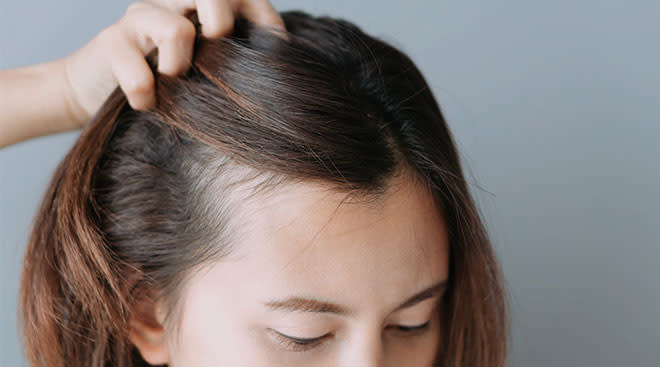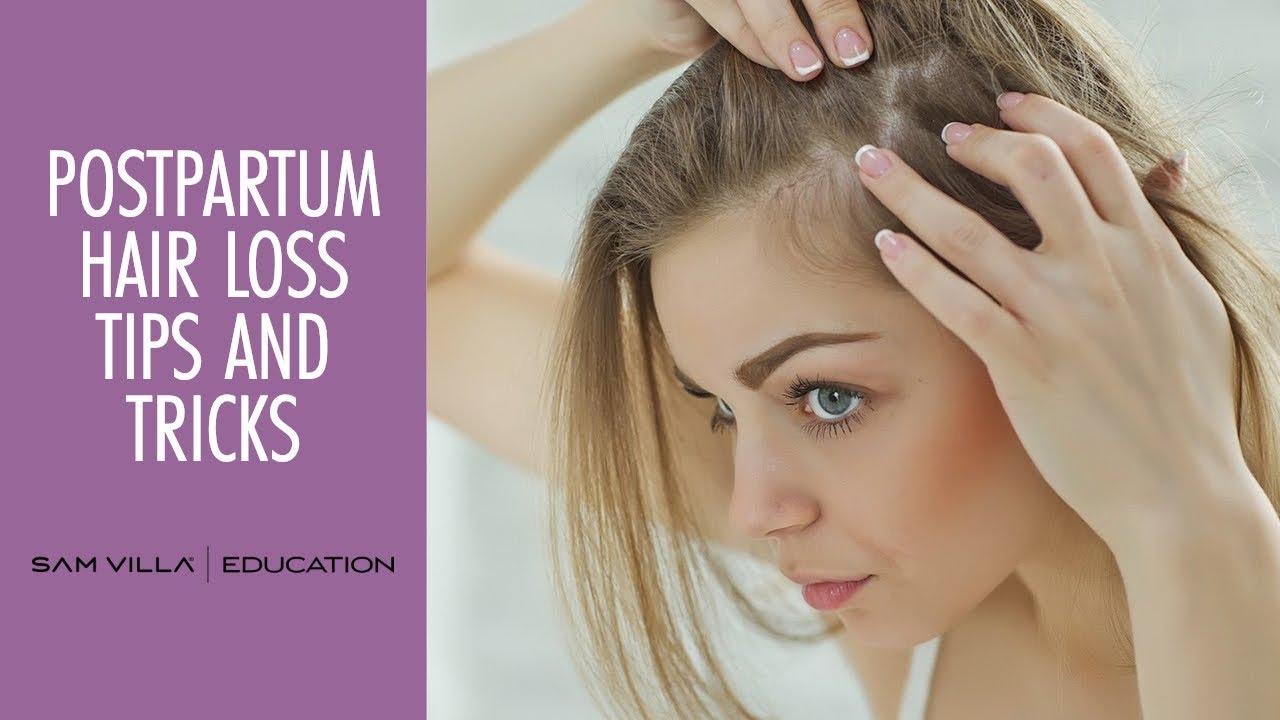Postpartum hair loss can be distressing but can be managed with proper hair care routines and healthy lifestyle choices. After giving birth, many new mothers experience postpartum hair loss, which can be a result of hormonal changes in the body.
While this is a common occurrence, it can still be distressing to see clumps of hair falling out. Fortunately, there are steps that can be taken to manage postpartum hair loss and promote healthy hair growth. A good hair care routine, with gentle products that do not strip the scalp, is essential.
A healthy diet and plenty of rest and exercise can also help. In this article, we will provide tips and advice for dealing with postpartum hair loss and regaining healthy hair.

Credit: www.thebump.com
Table of Contents
How Postpartum Hair Loss Works
Hair care for postpartum hair loss: how postpartum hair loss works
Postpartum hair loss is a typical condition many women face after giving birth. It occurs due to changes in hormone levels during pregnancy and childbirth, which can significantly affect the hair growth cycle. Understanding how postpartum hair loss works is essential for coping with the condition.
In this section, we discuss the hair growth cycle, changes in hormones after childbirth, and the shedding and regrowth phases.
Understanding The Hair Growth Cycle
Hair growth involves three phases: the anagen phase, the catagen phase, and the telogen phase. During the anagen phase, hair grows actively, which typically lasts for two to six years. The catagen phase is a transitional phase that lasts about two weeks, and hair growth stops during this time.
Finally, during the telogen phase, hair shedding occurs as the old hair falls out, making way for new hair growth to begin.
Changes In Hormones After Childbirth And How It Affects Hair
During pregnancy, the body experiences significant hormonal changes, resulting in increased levels of estrogen and progesterone. These hormones have a positive effect on hair growth and can extend the anagen phase, which can lead to thick, healthy hair. However, after giving birth, hormone levels drop suddenly, leading to a shift into the catagen phase and telogen phase, resulting in hair shedding.
Shedding And Regrowth Phases
Postpartum hair loss typically occurs one to five months after giving birth and can last up to a year. It is common to experience increased hair shedding during this time, and you might notice your hair become thin and dull.
However, it is essential to note that this hair loss is temporary, and hair regrowth will occur naturally as the hair growth cycle returns to normal.
Here are some tips to help with hair regrowth after postpartum hair loss:
- Eating a healthy, balanced diet that includes plenty of protein, vitamins, and minerals
- Avoiding hairstyles that pull hair tightly, which can cause traction alopecia
- Using gentle, sulfate-free shampoos and avoiding harsh chemicals on your hair
- Styling your hair gently and avoiding heat styling tools
- Consulting with a healthcare provider to rule out any underlying health conditions that might be contributing to hair loss
Understanding how postpartum hair loss works can help you cope with the condition and take appropriate steps to aid hair regrowth. While it can be distressing to experience hair loss after giving birth, remember that it is temporary, and your hair will recover naturally with time.
Take good care of your hair, and it will be back to its normal, healthy state in no time.
Tips For Hair Care During Postpartum Phase
Hair loss after giving birth is a common experience that many women face. Postpartum hair loss occurs due to hormonal changes, and while it can be distressing, it is temporary and usually resolves on its own. During this phase, practicing gentle hair care can help reduce hair breakage and promote healthy hair growth.
Here are some tips for caring for your hair during the postpartum phase.
Gentle Hair Care Practices
- Use a wide tooth comb or a brush with soft bristles to comb your hair gently.
- Avoid rubbing your hair with a towel after washing it, instead, pat it dry gently.
- Do not use styling tools on high heat as it can cause hair damage.
Choosing The Right Hairbrush And Comb
- Choose a brush or comb according to your hair type and texture.
- A wide-tooth comb is best for detangling, while a soft bristle brush is ideal for fine hair.
- Avoid using a brush or comb with sharp or tight bristles, as it can cause hair breakage.
Avoiding Tight Hairstyles And Accessories
- Avoid tight hairstyles such as braids, buns, and ponytails as it can cause hair breakage.
- Use hair accessories that do not pull or tug on your hair, such as soft hair ties or hair clips.
Nutritious Diet And Supplements For Hair Growth
A nutritious diet can help promote healthy hair growth. You should include foods that are rich in vitamins and minerals that are beneficial for your hair, such as:
Foods To Include In Your Diet
- Lean proteins such as poultry, fish, and eggs.
- Leafy greens such as spinach and kale.
- Foods rich in vitamin c such as oranges and strawberries.
- Whole grains such as brown rice and quinoa.
Supplements That May Help Promote Hair Growth
- Biotin supplements – biotin is a b-vitamin that is essential for hair growth and can be consumed as a supplement.
- Zinc supplements – zinc helps to maintain healthy hair and can be consumed as a supplement.
- Vitamin e supplements – vitamin e is an antioxidant that helps to improve blood circulation in the scalp and can be consumed as a supplement.
Choosing Hair Products Carefully
Choosing the right hair products is crucial for healthy hair growth. During the postpartum phase, you should avoid using products that contain harsh chemicals and ingredients that can cause further hair damage.
Avoiding Harsh Chemicals And Ingredients
- Sulfates – sulfates can strip away natural oils from your hair and scalp, causing dryness and irritation.
- Parabens – parabens are preservatives that are commonly used in hair products, but they have been linked to hair damage and hair loss.
- Silicones – silicones are used in hair products to add shine, but they can cause buildup and weigh down your hair.
Best Ingredients For Hair Growth And Strength
- Keratin – keratin is a protein that is naturally found in hair and is essential for hair growth and strength.
- Biotin – biotin is a b-vitamin that helps to promote healthy hair growth and strength.
- Omega-3 fatty acids – omega-3 fatty acids are essential for healthy hair growth and can be found in fish, nuts, and seeds.
By incorporating these tips into your daily hair care routine, you can help reduce hair breakage and promote healthy hair growth during the postpartum phase. Remember, postpartum hair loss is temporary, and your hair will eventually grow back to its pre-pregnancy state with a little bit of care and patience.
Styling Postpartum Hair
Postpartum hair loss can be a challenging experience for many women. While there is no definite way to prevent postpartum hair loss, there are ways to style and care for your hair to make it appear fuller and healthier. Here are some styling tips and hairstyles to help disguise thinning hair, add volume, texture, and enhance your hair’s overall appearance.
Best Hairstyles To Disguise Thinning Hair
- Bob cut: A chin-length bob is a comfortable, chic option that can make your hair look full.
- Layered cut: A layered cut can add volume and texture while taking the focus away from areas where the hair may be thinning.
- Pixie cut: A pixie cut can be an excellent option as it allows hair to stand up, creating an illusion of fullness while requiring minimal maintenance.
- Side-swept bangs: Strategically placing the bangs on one side of the face can frame the face, shift the focus away from thinning hair and flatter any face shape.
Styling Tips To Add Volume And Texture
- Blow-dry: Blow-drying on medium heat in the opposite direction of the hair can create volume and texture.
- Texturizing spray: A texturizing spray can give the hair a lift and reduce the appearance of flatness and thinning.
- Hair mousse: Apply hair mousse on the roots and the length of the hair before styling to create volume, fullness, and texture.
- Dry shampoo: Dry shampoo can add texture to hair and remove excess oil and dirt while transforming lifeless hair into voluminous locks.
Using Hair Accessories To Enhance Hair Appearance
- Scarves: Scarves can turn a bad hair day into a fashionable one. Use them to wrap around the head, tie into a bow, or turn into a headband to add flair to a simple hairstyle.
- Headbands: Headbands can keep hair in place while adding volume and texture. Choose a thick, textured headband to make hair appear fuller.
- Hair clips: Use hairclips to create an illusion of thicker hair by clipping hair in sections for a more voluminous look. Slicking back the hair on top and clipping hair towards the sides can add volume and texture.
Remember, styling can only enhance hair appearance temporarily. A healthy hair care routine, including a balanced diet, drinking plenty of water, and reducing stress, can encourage hair growth. Keep experimenting with different hairstyles, techniques, and hair care routines until you find what works best for you.
Frequently Asked Questions Of Hair Care For Postpartum Hair Loss
How Long Does Postpartum Hair Loss Last?
Postpartum hair loss can last up to one year after childbirth, but typically lasts for around six months.
Is Postpartum Hair Loss Normal?
Yes, postpartum hair loss is normal and experienced by many women due to hormonal changes after giving birth.
What Can I Do To Prevent Postpartum Hair Loss?
While postpartum hair loss cannot be prevented, maintaining a healthy diet, reducing stress and taking good care of your hair can minimize its effects.
Will My Hair Grow Back After Postpartum Hair Loss?
Yes, postpartum hair loss is a temporary condition and hair usually grows back within a few months.
Can I Color Or Dye My Hair During Postpartum Hair Loss?
It is best to wait until postpartum hair loss has stopped before coloring or dyeing your hair, to avoid further damage to your hair.
How Can I Care For My Hair During Postpartum Hair Loss?
Gently treating your hair, avoiding tight hairstyles, using a wide-tooth comb and moisturizing your scalp regularly can help take care of hair during the postpartum hair loss phase.
Conclusion
It’s understandable for new mothers to feel overwhelmed by postpartum hair loss. But with a few simple changes to their hair care routine, they can minimize the condition and regrow their hair. Starting with taking care of their scalp, incorporating a healthy diet, avoiding harsh chemicals, and using hair-strengthening products, can go a long way in improving their hair’s overall health.
New moms should also avoid tight hairstyles that can cause tension, as well as excessive heat styling and hair products that contain alcohol. Remember, hair loss is a common occurrence and part of the postpartum journey, but it’s not permanent.
By following these steps, new moms can take control of their hair health and boost their confidence, one step at a time.
